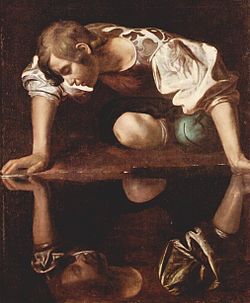In Greek mythology, Narcissus or Narkissos (Greek: Νάρκισσος), was a hero of the territory
of Thespiae in Boeotia who was renowned for his beauty. Several versions of his myth have survived: Ovid's, from his Metamorphoses; Pausanias', from his Guide to Greece, (9.31.7); and one found among the Oxyrhynchus papyri.
Pausanias locates the spring of Narcissus at Donacon 'Reed-bed' in the territory of the Thespians. Pausanias finds it incredible that someone could not distinguish a reflection from a real person, and cites a less known variant in which Narcissus had a twin sister. Both dressed similarly and hunted together. Narcissus fell in love with her. When she died, Narcissus pined after her and pretended that the reflection he saw in the water was his sister.
As Pausanias also notes, yet another tale is that the narcissus flower was created to entice Demeter's daughter Persephone away from her companions to enable Hades to abduct her.
Archaic Version
There is an older version than the one related by Ovid in his Metamorphoses, which is a moral tale in which the proud and unfeeling Narcissus is punished by the gods for having spurned all his male suitors. It is thought to have been intended as a cautionary tale addressed to adolescent boys. Until recently, the only source for this version was a segment in Pausanias (9.31.7), about 150 years after Ovid. A very similar account was discovered among the Oxyrhynchus papyri in 2004, however, an account that predates Ovid's version by at least fifty years.
In this story, Ameinias, a young man, loved Narcissus but was scorned. To tell Ameinias off, Narcissus gave him a sword as a present. Ameinias used the sword to kill himself on Narcissus' doorstep and prayed to Nemesis that Narcissus would one day know the pain of unrequited love. This curse was fulfilled when Narcissus became entranced by his reflection in the pool and tried to seduce the beautiful boy, not realizing it was himself he was looking at. He only realized that it was his reflection after trying to kiss it. Completing the symmetry of the tale, Narcissus took his sword and killed himself from sorrow. His corpse then turned into a flower.[1]
Narcissus died because he could only love his image at the expense of himself.
Influence
The myth of Narcissus has been a rich vein for artists to mine for at least two thousand years, beginning with the Roman poet Ovid (book III of Metamorphoses). This was followed in more recent centuries by other poets (Keats), and painters (Caravaggio, Poussin, Turner, Dalí, and Waterhouse). In Stendhal's novel Le Rouge et le Noir (1830), there is a classic narcissist in the character of Mathilde. Says Prince Korasoff to Julien Sorel, the protagonist, with respect to his beloved:
She looks at herself instead of looking at you, and so doesn't know you. During the two or three little outbursts of passion she has allowed herself in your favor, she has, by a great effort of imagination, seen in you the hero of her dreams, and not yourself as you really are. (Page 401, 1953 Penguin Edition, trans. Margaret R.B. Shaw).
The myth had a decided influence on English Victorian homoerotic culture, via the influence of Andre Gide's study of the myth Traite du Narcisse ('The Treatise of the Narcissus', 1891), and the influence of Oscar Wilde. Also, many characters in Fyodor Dostoevsky's (19th-Century Russian Writer) writings are lonely Narcissus-types, such as Yakov Petrovich Golyadkin in "The Double" (Published 1846).
In addition, Bob Dylan's song "License to Kill" the last verse hints at a reference to Narcissus. "Now he worships at an altar of a stagnant pool /And when he sees his reflection, he's fulfilled."





Tidak ada komentar:
Posting Komentar